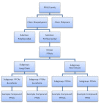Trends in the Regulation of Per- and Polyfluoroalkyl Substances (PFAS): A Scoping Review
- PMID: 34682663
- PMCID: PMC8536021
- DOI: 10.3390/ijerph182010900
Trends in the Regulation of Per- and Polyfluoroalkyl Substances (PFAS): A Scoping Review
Abstract
Products containing per- and polyfluoroalkyl substances (PFAS) have been used for decades in industrial and consumer products. These compounds are persistent in the environment, bioaccumulative, and some are toxic to humans and other animals. Since the early 2000s, laws, policies, and regulations have been implemented to reduce the prevalence of PFAS in the environment and exposures to PFAS. We conducted a scoping literature review to identify how PFAS are regulated internationally, at the U.S. national level, and at the U.S. state level, as well as drivers of and challenges to implementing PFAS regulations in the U.S. This review captured peer-reviewed scientific literature (e.g., PubMed), grey literature databases (e.g., SciTech Premium Collection), Google searches, and targeted websites (e.g., state health department websites). We identified 454 relevant documents, of which 61 discussed the non-U.S. PFAS policy, 214 discussed the U.S. national-level PFAS policy, and 181 discussed the U.S. state-level PFAS policy. The drivers of and challenges to PFAS regulation were identified through qualitative analysis. The drivers of PFAS policy identified were political support for regulation, social awareness of PFAS, economic resource availability, and compelling scientific evidence. The challenges to implementing PFAS regulations were political limitations, economic challenges, unclear scientific evidence, and practical challenges. The implications for PFAS policy makers and other stakeholders are discussed.
Keywords: PFAS; analysis; environment; exposure; policy; regulation.
Conflict of interest statement
The authors declare no conflict of interest.
Figures



References
-
- Simons J. presented before the Division of Physical and Inorganic Chemistry of the American Chemical Society, Portland, Oregon, September 1948. J. Eleclrochcm. Soc. 1949;95:47. doi: 10.1149/1.2776733. - DOI
-
- Teng H. Overview of the development of the fluoropolymer industry. Appl. Sci. 2012;22:496–512. doi: 10.3390/app2020496. - DOI
Publication types
MeSH terms
Substances
LinkOut - more resources
Full Text Sources

